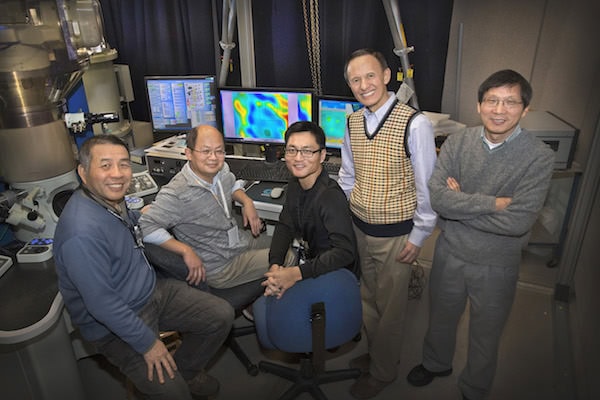
[Image above] Brookhaven scientists—from left to right, Jianming Bai, Feng Wang, Wei Zhang, Yimei Zhu, and Lijun Wu—at the Condensed Matter Physics and Materials Science Department’s TEM facility. Credit: Brookhaven National Laboratory
If there’s one thing we smartphone owners agree on, it’s that the batteries in our phones don’t last long enough. Between texting, searching the web, posting on Facebook, sharing videos, or live-streaming events, there never seems to be enough juice to carry us through the day.
Scientists continue to work on improving lithium-ion batteries—which power our smartphones, computers, electric vehicles, and other electronics—all in an effort to improve our overall lives.
Researchers have developed an electroplating method to improve battery life. Other scientists have designed electrodes out of MXenes, opening up faster travel paths for ions. And still other researchers are creating faster charging batteries with Gilsonite, an asphalt derivative.
And even though battery technology has come a long way, we still don’t seem to be happy with the current state of batteries.
A recent discovery by a team of scientists at the U.S. Department of Energy’s Brookhaven National Laboratory (BNL) could be a breakthrough in lithium-ion battery life. While observing a battery generating an electric current, the researchers noticed that the lithium concentration inside nanoparticles reversed at some point during the process.
Quick lithium-ion rechargeable battery tutorial: When a battery discharges, lithium ions flow in electrolyte from the negative electrode (anode) to the positive electrode (cathode), through a separator that blocks electron flow. When the battery charges, they move back across to the anode side, waiting to be discharged in another cycle.
According to Wei Zhang, one of the researchers, there is a belief that lithium would continue to increase in the lattice over time. “But now, we have seen that this may not be true when the battery’s electrodes are made from nanosized particles,” he states in a BNL news release. “We observed the lithium concentration within local regions of nanoparticles go up and then down—it reversed.”
Using nanoparticles for lithium-ion battery electrodes can increase conductivity and enable higher storage density of lithium—but without the right equipment, scientists haven’t really been able to observe them in action.
“Similar to how a sponge soaks up water, we can see the overall level of lithium continuously increase inside the nanosized particles,” Feng Wang, lead researcher and scientist in BNL’s Sustainable Energy Technologies Department, explains in the release. “But unlike water, lithium may preferentially move out of some areas, creating inconsistent levels of lithium across the lattice.”
According to Wang, when lithium ions move back and forth during charge/discharge cycles, the lattice stretches and shrinks each time—stressing it and contributing to its deterioration.
“Each time you charge and drain a battery, its active component will be stressed, and its quality will degrade over time,” he says. “Therefore, it is important to characterize and understand how lithium concentration changes both in space and time.”
The research team accessed special equipment to observe lithium ion behavior. Using transmission electron microscopy (TEM) and X-ray analyses, they were able to analyze the structure of nanoparticles and create a nanoscale model battery they could use in TEM. They also created a 2-D map illustrating lithium concentration inside a nanoparticle over time.

2-D maps depict the concentration of lithium inside a single nanoparticle over time. Credit: Brookhaven National Laboratory
The researchers believe that the lithium behavior they observed might also be happening in other types of high-performance batteries.
“Down the road, we plan to use the world-class facilities at CFN and NSLS-II to more closely examine how battery materials work and to find solutions for building new batteries that can charge faster and last longer,” Wang says.
And that might be good news for us impatient smartphone and laptop owners—but more importantly, for the electric vehicle industry.
The paper, published in Science Advances, is “Localized concentration reversal of lithium during intercalation into nanoparticles” (DOI: 10.1126/sciadv.aao2608).
Did you find this article interesting? Subscribe to the Ceramic Tech Today newsletter to continue to read more articles about the latest news in the ceramic and glass industry! Visit this link to get started.
Author
Faye Oney
CTT Categories
- Basic Science
- Electronics
- Energy
- Market Insights
- Nanomaterials


